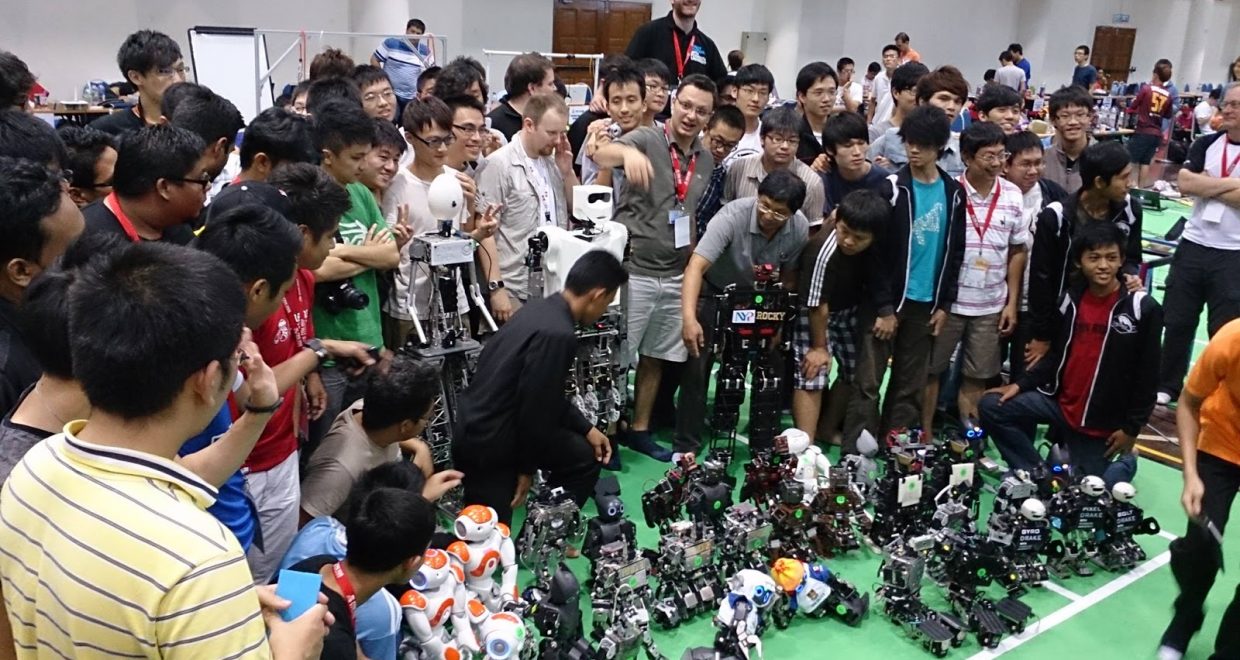Humanoid Multi-Event Robot Athletes
Jacky Baltes, guest Editor for Knowledge Engineering Review, introduces the special issue on Humanoid Multi-Event Robot Athletes
The FIRA HuroCup competition was started in 2002 to provide a challenging and state of the art benchmark problem for humanoid robots. Instead of focusing on a single event, FIRA HuroCup focuses on a single robot competing in multiple events, similar to the decathlon in track and field. The organizers of this competition believed strongly that variability and flexibility are cornerstones of human and artificial intelligence and that multi-event robot competitions serve as important benchmark problems. In 2017, the events of the HuroCup decathlon are: sprint, marathon, basketball, weight lifting, spartan race, obstacle run, long jump, united soccer, mini-drc, and for the first time archery.

Challenge problems involving sporting events have been an important part of evaluating performance in robotics and AI for more than twenty years. More recently, it has become a major focus for humanoid robotics, since advances in the capability of hardware and software, decreased costs, and the goal of having robots function in domains intended to be inhabited by humans have made humanoids an important and affordable tool for researchers.
Consequently a variety of humanoid robot competitions have become prominent. The highest profile of these are soccer playing robots (e.g., RoboCup and FIRA AndroSot).
Multi-events are popular for human athletes. Human decathletes are widely admired for their versatility and are refereed to as the king of athletes. Modern pentathlon (running, swimming, riding, fencing, shooting) is an Olympic event modeled on the necessary skills of a military scout.Olympic Triathlon (swimming, cycling, running), biathlon (cross country skiing and shooting), and Nordic combined (ski jumping and cross country skiing) are other Olympic multi-events.

Multi-event robot competitions are important benchmark problems because the required adaptability, flexibility, and versatility are cornerstones of human intelligence. Multi-event competitions also solve the problem of highly specialized special purpose solutions, the fact that, as games become more complex, teams attempt to “hack” the rules and to use special tricks that only work in this particular environment.

This greatly reduces the applicability of the developed solutions and leads to teams focusing on fine tuning rather than solving general issues in intelligent robotics and artificial intelligence. The most obvious example of this trend is the micro-mouse competition, which was initially setup as a challenge problem for robot navigation in a maze. But nowadays, the maze solving algorithms have been solved. As another example in 1998, at 2:00am, I helped repaint all the playing fields of the RoboCup Small Sized League because the center-line was 1mm wider than specified in the rules and a team complained that their vision system was unable to deal with this.
Multi-events also emphasize the versatility inherent in the humanoid form: it has thus far received little attention in the research literature that across the animal kingdom, the humanoid form is not particularly suited to excellence at a single task. Humans are not the fastest runners (cheetahs), best swimmers (dolphins), or most agile climbers (monkeys). However, the humanoid form is unique in that it is near the top in a broad range of activities.

The first paper in the special issue ‘HuroCup – Competition for Multi-Event Humanoid Robot Athletes’ by J. Baltes et al. introduces the philosophy and history behind the HuroCup competition. The paper also describes the progress made by teams participating in the competition as is evidenced by improved world records. For example, the best time for the 3m backward and forward sprint was reduced from 1 min 07.50 sec. to 21.50 sec. in 2017, and how in turn the organizers adapted the competition to maintain a focus on state of art research.
The papers ‘Stability margin for robust walking gaits constructed by center of pressure’ by Tu et al. and ‘Parameterized gait pattern generator based on LIPM with natural ZMP references’ by Ho et al. focus on walking gaits for humanoid robots in varying environments. The main contribution in the first is a more robust walking gait algorithm. The second paper uses an extended model of the dynamics of the legs of the robot to improve performance in walking and in kicking and other highly dynamic actions.
‘Active Balancing and Turning for Alpine Skiing Robots’ by Iverach-Brereton et al. describes the balancing algorithm of the first skiing humanoid robot. Skiing is an interesting domain because skiis provide good stability in the lateral direction, but poor stability in the frontal plane.

As researchers move from single robots to teams of collaborating robots, the ability to recognize other robots and to identify their pose becomes ever more important. This problem is addressed in ‘Inter-Humanoid Robot Interaction with Emphasis on Detection: A Comparison Study’ by Shangari et al.
Locomotion, especially over uneven terrain or with varying loads, is a challenging problem for humanoid robots. But navigation, that is the ability to localize the robot in the environment and to reach a target location without collisions, is also a crucial problem. ‘Vision-based Obstacle Avoidance System with Fuzzy Logic for Humanoid Robots’ by Shu et al. describes a solution for the obstacle run domain. The robot navigates through a color coded environment using a fuzzy logic controller.

I would like to thank the reviewers for their diligent work and insightful comments which greatly improved the quality of the final product. As associate editor and as researcher, I realize how difficult it is to nowadays receive insightful and constructive reviews and I really appreciate all the hard work of our anonymous reviewers.
The next FIRA competition will take place in Kaohsiung, Taiwan from 22nd to 27th August 2017. Please visit http://www.facebook.com/groups/FIRARobosoccer/ for more details.
The entire special issue will be freely available until the end of June.
Jacky Baltes
Guest Editor for Special Issue on Humanoid Multi-Event Robot Athletes
Director Educational Robotics Center
Department of Electrical Engineering
National Taiwan Normal University





